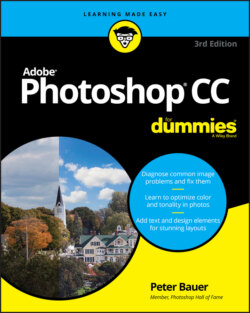Читать книгу Adobe Photoshop CC For Dummies - Peter Bauer - Страница 12
What Photoshop is designed to do
ОглавлениеAdobe Photoshop is an image-editing program. It’s designed to help you edit images — digital or digitized images, photographs, and otherwise. This is the core purpose of Photoshop. Over the years, Photoshop has grown and developed, adding features that supplement its basic operations. But at its heart, Photoshop is an image editor. At its most basic, Photoshop’s workflow goes something like this: You take a picture, you edit the picture, and you print the picture (as illustrated in Figure 1-1). (Of course, many images never make it to paper — they are shared only on social media.)
FIGURE 1-1: Basic Photoshop: Take photo, edit photo, print photo. Drink coffee (optional).
Whether captured with a digital camera, scanned into the computer, or created from scratch in Photoshop, your artwork consists of tiny squares of color, which are picture elements called pixels. (I explore pixels and the nature of digital imaging in-depth in Chapter 2.) Photoshop is all about changing and adjusting the colors of those pixels — collectively, in groups, or one at a time — to make your artwork look precisely how you want it to look. (Photoshop, by the way, has no Good Taste or Quality Art button. It’s up to you to decide what suits your artistic or personal vision and what meets your professional requirements.) Some very common Photoshop image-editing tasks are shown in Figure 1-2: namely, correcting red eye and minimizing wrinkles (both discussed in Chapter 8); and compositing images (see Chapter 9).
Astronaut image courtesy of NASA
FIGURE 1-2: Some common Photoshop tasks.
Photoshop works with actual vector shapes, such as those created in Adobe Illustrator. Photoshop also has a very capable brush engine, including erodible brush tips (they wear down and need to be resharpened) and airbrush and watercolor brush tips, further extending the fine art painting capabilities of the program. Figure 1-3 shows a comparison of raster artwork (the digital photo, left), vector artwork (the illustration, center), and digital painting (right). The three types of artwork can appear in a single image, too. (Creating vector artwork is presented in Chapter 10, and you can read about painting with Photoshop in Chapter 13.)
FIGURE 1-3: You can use Photoshop with raster images, vector shapes, and even to paint.
Photoshop also includes some basic features for creating web graphics, including slicing and animations (see Chapter 16 for info on video and animation). (Web work is best done in a true web development program, such as Dreamweaver. If you want to learn about creating websites, pick up a copy of Dreamweaver CC For Dummies [Wiley].)
